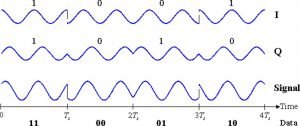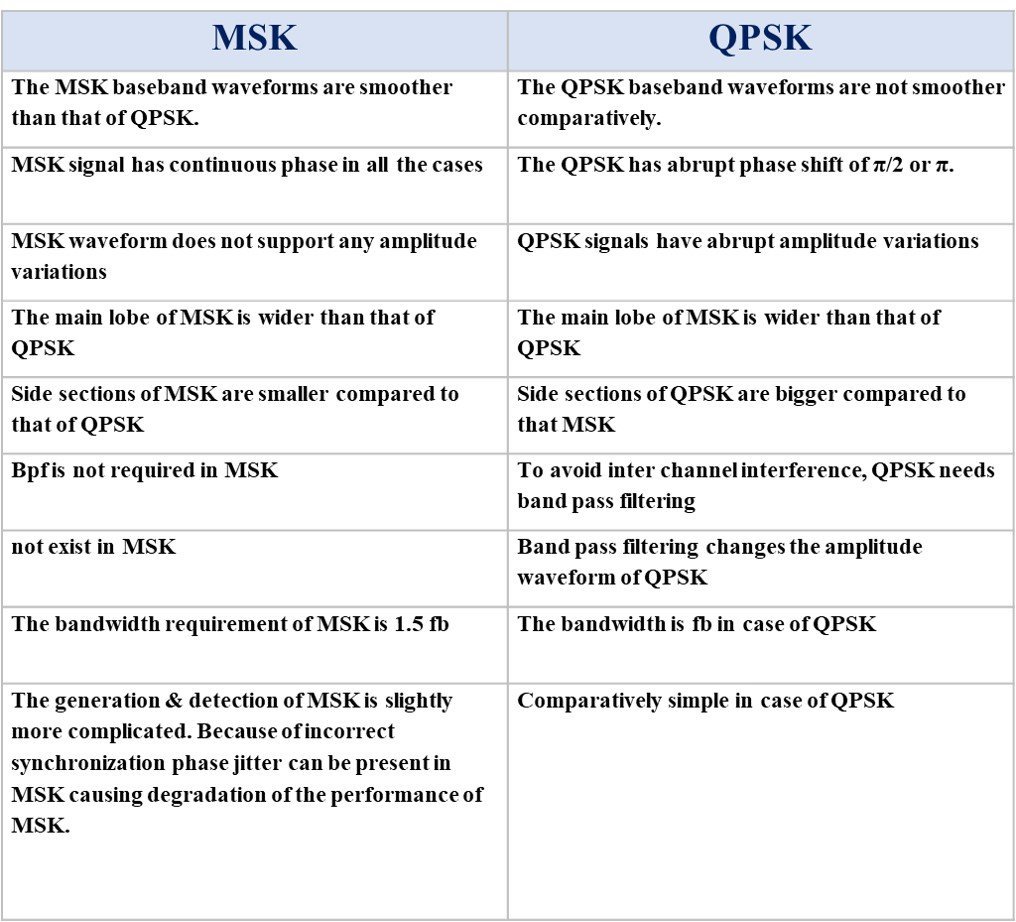Topic of Discussion: Digital Modulation Techniques
What is Digital Modulation?
Define Digital Modulation:
“The conversion of analog signal to digital signal is basically known as digital modulation in which a digital signal consists of binary digits.”
Fundamental Digital Modulation Methods:

What are the different techniques of modulating in digital communication?
The most important methods of digital modulations are:
- PSK (Phase Shift Keying) – In this Digital Modulation a certain number of phases are used.
- FSK (Frequency Shift Keying) – In this shift keying method, an exact or limited number of frequencies are used.
- ASK (Amplitude Shift Keying) – In this shift keying method, an exact & limited number of amplitudes are used.
- QAM (Quadrature Amplitude Modulation) – Here minimum 2 separate phase and 2 separate amplitude are taken.
What is QPSK Modulation?
Explain the working of QPSK:
QPSK is a digital modulation technique in which two successive bits in the data sequence are grouped together so as to achieve better bandwidth efficiency. As the bits are grouped together to form symbols, the bit rate or signaling rate (fb) is reduced which reduces the bandwidth of the channel.
QPSK may be treated as an M-array PSK modulation scheme in which M=4. In a QPSK system, if we combine two successive bits, as a result we will get four distinct symbols. As one symbol changes to the next symbol, the phase of the carrier changes by 90˚ or π/2 radian. Each symbol is called a di-bit.
As an example, the four di-bits may be 00, 01, 11 in natural coded form or 00, 10, 11, 01 in Gray encoded form may be represented as shown below:
QPSK signals can be expressed as
S(t) = Ac cos Ø(t) 2πfct – Ac sin Ø (t) sin ) 2πfct
Where, Ac cos Ø (t) forms the in-phase component and Ac sin Ø (t) forms the quadrature component. The QPSK signals can be generated based on the in-phase and quadrature components as well.

Image credit: Splash, QPSK timing diagram, CC BY-SA 3.0
What is coherent detection technique?
Describe ASK demodulation through coherent detection:
In coherent detection technique, a local carrier is used for detection. A local carrier signal made at the receiver’s end and will be phase-locked at the transmitter’s end. The received signal is heterodyned with the local carrier to generate the baseband signal.
The coherent detection of ASK is a locally generated signal of the same frequency and phase as the transmitted signal is applied to a product modulator as shown below
The integrator integrates the output signal of the product modulator over a bit interval, Tb and the output of the integrator is compared with the pre-set threshold in a decision device. If the threshold gets exceeded, it gives 1 as a symbol & if the threshold is not exceeded it gives 0.
A synchronous or coherent detector should have two forms of synchronization; phase synchronization. Phase synchronization is necessary because it ensures locking in phase of the locally generated carrier wave with the transmitted signal. Timing synchronization is one of the most important factor here because it gives a fixed and particular timing of the decision-making operation in the receiver with respect to the switching instants.
Why is DPSK scheme of carrier modulation has been used?
DPSK in Modulation Technique:
We know there is a requirement of synchronization of phase in coherent receiver with BPSK without any discrete carrier term. A phase lock loop circuit may be used to extract the carrier reference only if a low-level pilot carrier is transmitted along with the BPSK signal.
In absence of a carrier, a squaring loop may be used to synchronize the carrier reference from this BPSK signal for providing coherent detection. But this introduces a 180˚ phase ambiguity. In order to eliminate this problem of 180˚ phase ambiguity a differential coding technique is used at the transmitter and a differential decoding is used at the receiver. This signaling technique of combining differential encoding with phase shift keying (PSK) is called differential phase shift keying or DPSK.
In DPSK, the input sequence of the binary bits is arranged in a way that the next bit has to rely on the previous bit. In the receiver’s end, the opposite happens i.e., the earlier received bit is utilized for detection of the current bits.
What are the advantages of PSK over ASK?
- ü Phase Shift Keying is used to carry data over RF signal more efficiently than other modulation types. Hence this method is power effective.
- In PSK, less errors occur compared to ASK modulation and also occupies the same bandwidth as ASK.
- Better rate of data transmission usually attained by PSK i.e., QPSK, 16 QAM etc.
What are the major differences between QAM and QPSK?
QAM differs with QPSK in the matter of spectral-width.
- The QPSK’s spectral width is wider than the QAM.
- Additionally, QAM has high Bit Error Rate than QPSK.
What are the major differences between QPSK and PSK?
- For Phase Shift Key, the shift of phases occur in 180 degrees. In case of QPSK, the shift is multiple of Ninety Degrees.
- QAM is a group of Amplitude Shift Key and Phase Shift Key.
Comparison of Binary Modulation and M-Array Modulation:
- The word binary signifies two-bits. Binary Modulation is the type of digital modulation technique.
- M simply denotes a digit that matches to the number of combinations possible for a specified number of binary variables. M-Array Modulation is the type of digital modulation technique
What are the differences between MSK and QPSK?

Performance metrics for digital modulation scheme:
The bit error rate, power spectra and bandwidth efficiency are some of the performance metrics of digital communication system. The desirable characteristic’s
- BER should be good and in limit.
- Signal transmission should happen including lesser transmission bandwidths.
- There should be use of Minimal amount of transmission power.
- The system should be of less cost.
To know more about line coding click here

Hi, I am Soumali Bhattacharya. I have done Master’s in Electronics.
I am currently invested in the field of Electronics and communication.
My articles are focused on the major areas of core electronics in a very simple yet informative approach.
I am a vivid learner and try to keep myself updated with all the latest technologies in the field of Electronics domains.
Let’s connect through LinkedIn –